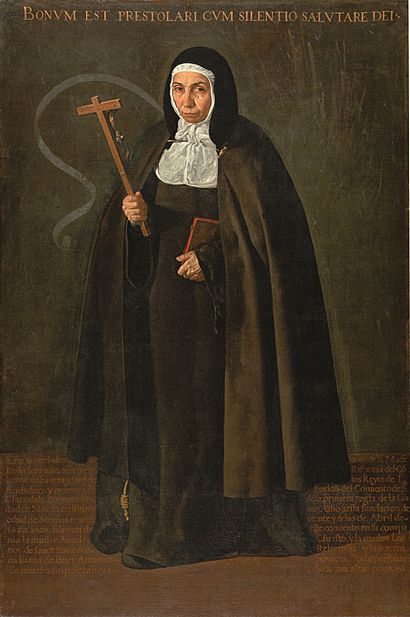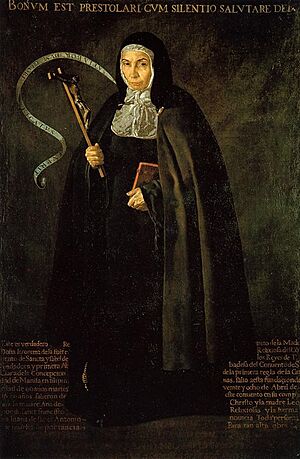The Nun Jerónima de la Fuente facts for kids
Quick facts for kids The Nun Jerónima de la Fuente |
|
|---|---|
 |
|
| Artist | Diego Velázquez |
| Year | 1620 |
| Type | Oil on canvas |
| Dimensions | 160 cm × 110 cm (63 in × 43 in) |
| Location | Museo del Prado, Madrid, Spain |
| Website | at Museo del Prado |
The Nun Jerónima de la Fuente is a famous portrait painting by Diego Velázquez. It shows a nun named Jerónima de la Asunción. Velázquez painted this artwork in 1620 using oil paints on a canvas. Today, you can see it at the Museo del Prado in Madrid, Spain.
The Painting's Story
This painting was first shown in 1926. People thought it was painted by an artist named Luis Tristán. But after it was cleaned and fixed, Diego Velázquez's signature was found!
Velázquez painted Jerónima in June 1620. At that time, Jerónima de la Asunción was stopping in Seville, Spain, for two months. She was on her way to the Philippines. A group of Franciscans (a type of religious order) or a church leader named Alvaro de Villegas asked Velázquez to paint her.
Jerónima is one of the first portraits Velázquez ever painted. It also shows how well-known Jerónima was becoming. At the time, she was much more famous than Velázquez. This painting helped Velázquez become more recognized. It was a big step in his career, and he later became a painter for the royal court.
The full-size portrait is now in Madrid at the Museo del Prado. The museum bought it from the Santa Isabel convent in 1944. There is a very similar copy of the painting still in Toledo. Also, a smaller version of The Nun Jerónima de la Fuente exists. It was painted by Velázquez or one of his students. This smaller painting is owned by a private collector in Santiago de Chile.
What the Painting Shows
Velázquez's painting shows Jerónima standing against a dark background. She holds a small book in her left hand. In her right hand, she holds a wooden crucifix (a cross with Jesus on it).
At the top of the painting, there's a quote from the Book of Lamentations (a book in the Bible). It says, "Bonvm est prestolari cvm silentio salvtare dei." This means, "It is good to await the salvation of God in silence."
Near the nun's mouth, there's a scroll with words on it. It says, "Satiabor dvm glorificatvs fverit," which means, "I shall be satisfied as long as he is glorified." This is a changed verse from the Psalms (another Bible book).
At the bottom, there's a long message in Spanish. It explains who the nun is: "This is the true portrait of Madre Donna Jerónima de la Fuente, a nun from this convent of St. Isabel de los Reyes, in Toledo. She was the founder and first leader of the convent of Sta. Clara de la Concepcion in Manila, in the Philippine Islands. She started this new convent when she was 66 years old, on Tuesday, April 28, 1620. Madre Ana de Cristo, Madre Leonor de Sanct Francisco, and Sor Juana de Sanct Antonio (a new nun) left with her from this convent. All of them were very important people for such a great work."
When Velázquez painted Jerónima, he was greatly influenced by his father-in-law and teacher, Francisco Pacheco. The painting is known for its "tight brushstrokes." It also uses a technique called chiaroscuro. This means it uses strong contrasts between light and dark. This makes her face and hands look very real, showing Velázquez's focus on realism before he moved to Madrid. The painting creates a "sacred image" that feels very true. It shows Jerónima as a perfect example of a holy person. Velázquez also used ideas from other paintings of Franciscan saints and important figures. These included Elizabeth of Portugal and Clare of Assisi, as well as some of Pacheco's own artworks.
Why This Painting is Important
Velázquez's painting is important because it shows the nun's older features in detail. At the same time, it captures her holiness. Vicente Carducho, an art writer, wrote in 1633 that Jerónima "evokes the legitimate love of parents, siblings, relatives, or friends." He believed it would help ease the sadness felt by the nuns in Toledo when Jerónima left.
The religious symbols in Jerónima, especially the crucifix, show her deep devotion to Christ. Another nun, Ana, said that Jerónima would show her faith "with a cross." Sometimes, she would even hold herself like she was on a cross for hours. The Latin words in the portrait also show her strong faith. They refer to the Poor Clares' practice of not talking too much or unnecessarily.
However, the painting does not show Jerónima's practice of self-discipline, which was well-known. Other stories about the nun described her body as "dry and denigrated," "full of scars and wounds." But in Velázquez's portrait, Jerónima has no scars or wounds. She looks "unscathed" and stands tall with a strong gaze. This makes her look powerful and respected.
See also
 In Spanish: La venerable madre Jerónima de la Fuente para niños
In Spanish: La venerable madre Jerónima de la Fuente para niños
- List of works by Diego Velázquez


